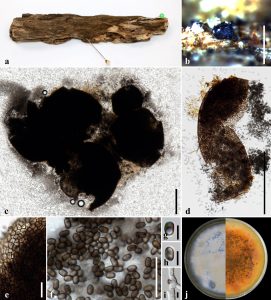Westerdykella purpurea (Cain) Arx, Kavaka 3: 33 (1976) [1975]
≡ Preussia purpurea Cain, Canadian Journal of Botany 39 (7): 1647 (1961)
Index Fungorum number: IF325553;
Saprobic in submerged decaying wood in a freshwater habitat. Asexual morph: Undetermined. Sexual morph: Ascomata 300–530 μm, cleistothecial, globose to subglobose, black, shiny, smooth, superficial, without ostiole. Peridium thin, membranaceous. semitransparent, with outer single layer of light olivaceous-brown, thin-walled, very distinct, wall layers, composed of brown cells of textura angularis with inner thicker layer of hyaline, swollen cells. Pseudoparaphyses a few hyaline, swollen cells, disappearing at maturity. Asci 8-spored, globose or subglobose, rarely more elongated and oval. Ascospores 2.5–6 × 1.5–4 μm (x̅ = 4.71–2.61 μm), irregularly crowded in ascus, ellipsoid, light olivaceous-brown, smooth, with two prominent oil globules.
Culture characteristics – Ascospores germinating on MEA within 24 h and germ tubes produce from the basal part of the ascospores. Colonies on the MEA, circular, powdery, aerial, flat, initially white mycelium then becoming light yellow in old cultures, entire margin, yellowish orange reverse, 20–25 mm diam. after 15 days at 25 °C.
Material examined – Thailand, Phitsanulok Province, Wang Thong District, Kaeng Sopha waterfall stream, on submerged wood, 25 July 2019, S. Boonmee, PSL/WT-05 (MFLU 20-0553), culture MFLUCC 20-0140.
GenBank submissions – ITS: MT465323, LSU: MT447879
Known distribution (based on molecular data) – Africa (Ebead et al. 2012), China (Jie et al. 2015), Thailand (this study)
Known hosts (based on molecular data) – mangrove sediment (Jie et al. 2015), sandy soil (Ebead et al. 2012), unidentified decaying wood (this study)
Notes – Preussia purpurea was synonymized by Arx (1975) under Westerdykella purpurea. In the phylogenetic analysis, W. purpurea is closely related to W. capitulum, W. dispersa and W. aurantiaca. The morphology of our collection (MFLUCC 20-0140) resembles W. purpurea in having ellipsoid, light olivaceous-brown, smooth-walled conidia, with two prominent oil globules (Cain 1961). Multi-gene phylogeny indicates that our collection grouped with other strains of W. purpurea with high bootstrap support (100% ML, 0.94 BYPP). Westerdykella purpurea differs from the type species W. ornata in the ascus shape (globose to subglobose vs. subglobose to elliptical) and size (15–22 × 12–16 μm vs. 25–32 × 16–22 μm) including the number of ascospores (8-spored vs. 32-spored). Furthermore, the former has light olivaceous-brown, ellipsoidal, 4–5.5 × 2.8–3.4 μm ascospores with two prominent oil globules, while the latter has globose, brown 6.2–7 × 6–6.8 μm ascospores and are ornated by irregular spiral bands, which occur in four to five coils. Based on morphology and phylogenetic analysis, we introduce a new geographical and habitat record of Westerdykella purpurea.

Westerdykella purpurea (MFLUCC 20-0140), new geographical and habitat record). a Appearance of the host tissue. b Appearance of ascomata on host. c–d Squash mounts of ascomata. e Peridium. f–h Ascospores. i Germinating conidia. j Obverse and reverse view of colony on MEA, 25 days at 25oC. Scale bars: b = 500 μm, c–d = 200 μm, e–f 20 μm, g–i = 5 μm.
